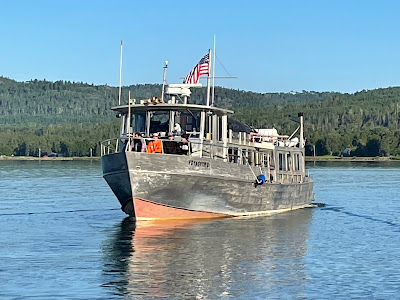The George M. Cox - The Rest of the Story
“But there was another sound on the lake, the steam whistle of a ship in the fog. And you can imagine his shock, when he saw from his vantage point at the top of the Lighthouse, the mast of a steamship moving through the fog at full speed. Continuing to Sound the Foghorn, (Rock of Ages lighthouse keeper) Soldenski fully expected the ship to steer away, but the minutes passed, and its fate was sealed. He heard the sound of grinding metal, as the Steamship George M. Cox, passengers just sitting down for their evening meal, dragged herself over the reef. Distress whistles cut through the still air with a piercing chill. Quickly Soldenski prepared his own motor launch and headed out into the fog towards the wreck.”
Each Saturday the Crew Leader fulfills a commitment to the Park Service on the part of ROALPS to present the history of the Rock of Ages Lighthouse and the Preservation Society to park goers as part of the Rangers Interpretive Talk series. In that presentation, reference is made to Head Lighthouse Keeper John Soldenski and his role in rescuing 125 people off of the wreck of the George M. Cox in 1933.
“Looming high out the lake before him was the bow of the George M. Cox, hovering at least 10 feet above the surface of the water, with 110 feet of her keel clearly exposed. Taking lifeboats in tow, Soldenski made his way back to the Light. In the end, 125 survivors shared the Lonely Rock that night, crowding themselves on the spiral stairs of the tower and on the rock outside until they could be taken by ship back to Houghton the following day. Without loss of life, a record 125 persons were rescued that day by the Keepers at Rock of Ages Lighthouse. The wreck of the George M. Cox held fast to the reef until late fall storms broke her up, and she slid into deep water.”
The Cox, named after it’s owner, was to be a short haul excursion boat and floating hotel in Chicago following its maiden voyage and tribute to the Chicago Century of Progress Exposition, going from Chicago to Port Arthur (Thunder Bay). She never made Thunder Bay, instead grounding herself on the Rock of Ages reef, near the other two “C” shipwrecks on the reef - the Cumberland of 1877, and the Henry Chisholm of 1898, neither of whom had the benefit of a Lighthouse.
Soldenski was not the only witness to the wreck. Stan Sivertson had already witnessed a wreck five years earlier. The America, with his father on board, sank in the north gap (see related post.) The first he knew of it was when he was awakened out of a deep sleep at 3:00 a.m. with his father shouting, “The America is Sinking, the America is sinking.” As he stumbled out of his bed, he saw his father pulling on the oars of a row boat. When he brought his own boat across, he saw the stern of the America fall under water, as the bow pointed skyward.
Now, five years later he heard a boat blowing distress signals, but ignored them. Since the signals seemed to come from the same area in which he and brother Art and Tommy Eckel found a distressed freighter laying still in the fog but unharmed among the reefs two weeks earlier. After responding to those distress signals, they found the captain of the freighter demanding that they help him out of there, rejecting their recommendation to wait for the fog to clear, and threatening to use a gun. Under duress, they managed to guide the freighter out of the reef, but had no interest in repeating the rescue for what they assumed was the same fool.
Now, five years later he heard a boat blowing distress signals, but ignored them. Since the signals seemed to come from the same area in which he and brother Art and Tommy Eckel found a distressed freighter laying still in the fog but unharmed among the reefs two weeks earlier. After responding to those distress signals, they found the captain of the freighter demanding that they help him out of there, rejecting their recommendation to wait for the fog to clear, and threatening to use a gun. Under duress, they managed to guide the freighter out of the reef, but had no interest in repeating the rescue for what they assumed was the same fool.
“In the morning it cleared up and when we went out to our nets, we saw this big white thing out there - couldn’t believe our eyes.” Stan Sivertson, interviewed in Peter Oikarinen’s “Island Folk”, 2008
Over the next several weeks, islanders from Washington Harbor took advantage of the law of the sea that says if you’re a volunteer, and the property is in danger or risk of loss, you can “save” that property in anticipation of a reward from the owner. Or keep it if the owner declines to provide a reward.
From “Island Folk”: “Besides cargo, Stanley and friends found a few suitcases and briefcases with names and addresses. They wrote to the people, but strangely they never answered. ‘Maybe they were ashamed to be on that boat,” Stanley added with no explanation.”
Though they retrieved some cargo, they missed the 150 cases of beer rumored to be aboard, and the hundreds of lifejackets that could have been sold as souvenirs, perhaps earning more than the value of a season of fishing.





A few facts I was not aware of….
ReplyDeleteCarry on, Word Scribe 😎